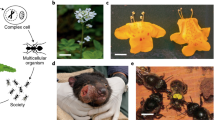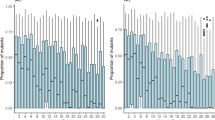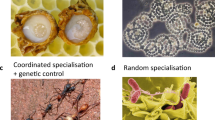Abstract
Most genes affect many traits1,2,3,4. This phenomenon, known as pleiotropy, is a major constraint on evolution because adaptive change in one trait may be prevented because it would compromise other traits affected by the same genes2,4. Here we show that pleiotropy can have an unexpected effect and benefit one of the most enigmatic of adaptations—cooperation. A spectacular act of cooperation occurs in the social amoeba Dictyostelium discoideum, in which some cells die to form a stalk that holds the other cells aloft as reproductive spores5,6. We have identified a gene, dimA7, in D. discoideum that has two contrasting effects. It is required to receive the signalling molecule DIF-1 that causes differentiation into prestalk cells. Ignoring DIF-1 and not becoming prestalk should allow cells to cheat by avoiding the stalk. However, we find that in aggregations containing the wild-type cells, lack of the dimA gene results in exclusion from spores. This pleiotropic linkage of stalk and spore formation limits the potential for cheating in D. discoideum because defecting on prestalk cell production results in an even greater reduction in spores. We propose that the evolution of pleiotropic links between cheating and personal costs can stabilize cooperative adaptations.
This is a preview of subscription content, access via your institution
Access options
Subscribe to this journal
Receive 51 print issues and online access
$199.00 per year
only $3.90 per issue
Buy this article
- Purchase on Springer Link
- Instant access to full article PDF
Prices may be subject to local taxes which are calculated during checkout




Similar content being viewed by others
References
Wright, S. Evolution and the Genetics of Populations Vol. 1 (Univ. of Chicago Press, Chicago, 1968)
Barton, N. H. Pleiotropic models of quantitative variation. Genetics 124, 773–782 (1990)
Featherstone, D. E. & Brodie, K. Wrestling with pleiotropy: genomic and topological analysis of the yeast expression network. BioEssays 24, 267–274 (2002)
Otto, S. P. Two steps forward, one step back: the pleiotropic effects of favoured alleles. Proc. R. Soc. Lond. B 271, 705–714 (2004)
Strassmann, J. E., Zhu, Y. & Queller, D. C. Altruism and social cheating in the social amoeba Dictyostelium discoideum. Nature 408, 965–967 (2000)
Kessin, R. H. Dictyostelium: Evolution, Cell Biology and the Development of Multicellularity (Cambridge Univ. Press, Cambridge, 2001)
Thompson, C. R. L., Fu, Q., Buhay, C., Kay, R. R. & Shaulsky, G. A bZIP/bRLZ transcription factor required for DIF signaling in Dictyostelium. Development 131, 513–523 (2004)
Maynard Smith, J. & Szathmáry, E. The Major Transitions in Evolution (Freeman, New York, 1995)
Atzmony, D., Zahavi, A. & Nanjundiah, V. Altruistic behaviour in Dictyostelium discoideum explained on the basis of individual selection. Curr. Sci. 72, 142–145 (1997)
Keller, L. (ed.) Levels of Selection in Evolution (Princeton Univ. Press, Princeton, New Jersey, 1999)
Frank, S. A. Repression of competition and the evolution of cooperation. Evolution 57, 693–705 (2003)
Velicer, G. J. Social strife in the microbial world. Trends Microbiol. 11, 330–337 (2003)
Fortunato, A., Strassmann, J. E., Santorelli, L. & Queller, D. C. Co-occurrence in nature of different clones of the social amoeba, Dictyostelium discoideum. Mol. Ecol. 12, 1031–1038 (2003)
Thompson, C. R. L. & Kay, R. R. The role of DIF-1 signaling in Dictyostelium development. Mol. Cell 6, 1509–1514 (2000)
Kay, R. R. & Thompson, C. R. L. Cross-induction of cell types in Dictyostelium: evidence that DIF-1 is made by prespore cells. Development 128, 4959–4966 (2001)
Leach, C. K., Ashworth, J. M. & Garrod, D. R. Cell sorting out during the differentiation of mixtures of metabolically distinct populations of Dictyostelium discoideum. J. Embryol. Exp. Morphol. 29, 647–661 (1973)
Thompson, C. R. L. & Kay, R. R. Cell-fate choice in Dictyostelium: intrinsic biases modulate sensitivity to DIF signaling. Dev. Biol. 227, 56–64 (2000)
Insall, R. et al. CRAC, a cytosolic protein containing a pleckstrin homology domain, is required for receptor and G protein-mediated activation of adenylyl cyclase in Dictyostelium. J. Cell Biol. 126, 1537–1545 (1994)
Jermyn, K. A. & Williams, J. G. An analysis of culmination in Dictyostelium using prestalk and stalk-specific cell autonomous markers. Development 111, 779–787 (1991)
Shaulsky, G. & Loomis, W. F. Cell type regulation in response to expression of ricin A in Dictyostelium. Dev. Biol. 160, 85–98 (1993)
Ponte, E., Bracco, E., Faix, J. & Bozzaro, S. Detection of subtle phenotypes: the case of the cell adhesion molecule csA in Dictyostelium. Proc. Natl Acad. Sci. USA 95, 9360–9365 (1998)
Queller, D. C., Ponte, E., Bozzaro, S. & Strassmann, J. E. Single-gene greenbeard effects in the social amoeba, Dictyostelium discoideum. Science 299, 105–106 (2003)
Visick, K. L., Foster, J., Doino, J., McFall-Ngai, M. & Ruby, E. G. Vibrio fischeri lux genes play an important role in colonization and development of the host light organ. J. Bacteriol. 182, 4578–4586 (2000)
Vulic, M. & Kolter, R. Evolutionary cheating in Escherichia coli stationary phase cultures. Genetics 158, 519–526 (2001)
Riley, M. A. & Wertz, J. E. Bacteriocins: evolution, ecology, and application. Annu. Rev. Microbiol. 56, 117–137 (2002)
Travisano, M. & Velicer, G. J. Strategies of microbial cheater control. Trends Microbiol. 12, 72–78 (2004)
Keller, L. & Nonacs, P. The role of queen pheromones in social insects: queen control or queen signal? Anim. Behav. 45, 787–794 (1993)
Hurst, L. D., Atlan, A. & Bengtsson, B. O. Genetic conflicts. Q. Rev. Biol. 71, 317–364 (1996)
Nunney, L. in Levels of Selection in Evolution (ed. Keller, L.) 238–252 (Princeton Univ. Press, Princeton, New Jersey, 1999)
Hamilton, W. D. The genetical evolution of social behavior I and II. J. Theor. Biol. 7, 1–52 (1964)
Acknowledgements
Thank you to N. Mehdiabadi and G. Velicer for helpful comments. This material is based upon work supported by the National Science Foundation, and C.R.L.T. was supported by a Wellcome Trust International Prize Travelling Research Fellowship.
Author information
Authors and Affiliations
Corresponding authors
Ethics declarations
Competing interests
The authors declare that they have no competing financial interests.
Rights and permissions
About this article
Cite this article
Foster, K., Shaulsky, G., Strassmann, J. et al. Pleiotropy as a mechanism to stabilize cooperation. Nature 431, 693–696 (2004). https://doi.org/10.1038/nature02894
Received:
Accepted:
Issue Date:
DOI: https://doi.org/10.1038/nature02894
This article is cited by
-
Synergistic inter-clonal cooperation involving crosstalk, co-option and co-dependency can enhance the invasiveness of genetically distant cancer clones
BMC Ecology and Evolution (2023)
-
The impact of food availability on tumorigenesis is evolutionarily conserved
Scientific Reports (2023)
-
Mutualism-enhancing mutations dominate early adaptation in a two-species microbial community
Nature Ecology & Evolution (2023)
-
Allopatric divergence of cooperators confers cheating resistance and limits effects of a defector mutation
BMC Ecology and Evolution (2022)
-
Host control and the evolution of cooperation in host microbiomes
Nature Communications (2022)
Comments
By submitting a comment you agree to abide by our Terms and Community Guidelines. If you find something abusive or that does not comply with our terms or guidelines please flag it as inappropriate.



